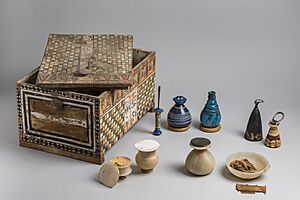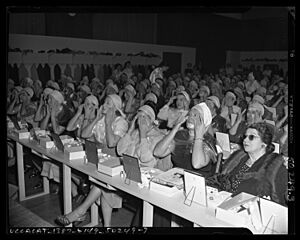History of cosmetics facts for kids
The history of cosmetics goes back at least 7,000 years! People in almost every society on earth have used them. Some experts believe that using body art with cosmetics was one of the first human rituals. We know this because ancient humans used red mineral pigments, like crayons, when Homo sapiens first appeared in Africa. Even the Old Testament mentions cosmetics. For example, in 2 Kings 9:30, Jezebel painted her eyelids around 840 BC. The book of Esther also talks about different beauty treatments.
People in ancient Rome also used cosmetics. However, many Roman writers didn't approve of them. We know that some Roman women created their own makeup. This included formulas with lead to make skin look whiter. They also used kohl to line their eyes.
Contents
Cosmetics in Africa
Ancient Egypt's Beauty Secrets
One of the first cultures to use cosmetics was ancient Egypt. Both men and women in Egypt used makeup to look better. The first cosmetics appeared there about 5,000 years ago.
To make their skin smell nice and feel soft, Egyptians used special oils. Women also put white makeup on their faces to protect them from the sun. The Egyptians were also the first to use black paint made from antimony as eyeliner. To get a natural blush, they crushed flowers.
The use of cosmetics in Ancient Egypt is well known. Kohl originated in North Africa. Black kohl eyeliner and dark eyeshadows (like blue, red, and black) were very common. You can see them in Egyptian art and even in Egyptian hieroglyphs.
Ancient Egyptians also made face paint from plants and minerals. Some of these early makeups were not safe. For example, some bromine-based makeup was very toxic. Lipsticks with a shimmering effect were first made using a shiny substance from fish scales. This is still used today!
Even with some dangerous ingredients, ancient Egyptian makeup was thought to have good properties. It was believed to help prevent infections. To treat wrinkles, they used ingredients like tree sap and fresh moringa. For scars and burns, they made a special cream from red ochre, kohl, and sycamore juice. They also chewed herbs or frankincense to improve their breath. Jars of what looked like hair gel have been found. These contained a mix of beeswax and tree resin. These products also helped with problems like baldness and graying hair. Egyptians even used these products on mummies. They believed it would make them look good in the afterlife.
Masonjoany in Madagascar
Since the 9th century, women of the Sakalava and Vezo in Madagascar have worn masonjoany. This is a decorative paste made from ground wood. They wear it on their faces as sunscreen and to keep insects away. It's also a beautiful decoration. Women paint flowers, leaves, and stars in white and yellow pastes. This tradition came from cultural exchange between the Malagasy people and Arab merchants in the island's northwest coastal area.
Cosmetics in the Middle East
Cosmetics are mentioned in the Old Testament. For example, in 2 Kings 9:30, Jezebel painted her eyelids around 840 BC. The book of Esther also describes beauty treatments.
Both men and women used cosmetics throughout the ancient Near East. This includes the civilizations of ancient Mesopotamia, Ancient Egypt, and Iran. Eye makeup like kohl was used in Persia and what is now Iran for a very long time. Kohl is a black powder that was widely used across the Persian Empire. It was used as a powder or smeared to darken the edges of the eyelids, much like eyeliner.
Cosmetics, especially kohl, were very important in the Middle East. They not only protected eyes but also had cultural meaning. Making kohl involved burning a substance and mixing it with galena, a lead compound. Ancient graves have shown that women were buried with jewelry, pottery, and seashells containing kohl. Kohl was also believed to reduce eye swelling.
The Middle East's traditions, shaped by Islamic rules, affect daily life, including cosmetics. Cosmetics were used throughout the Middle East and Near East after Islam began. A special type of kohl called Ithmid kohl has been used for over 15 centuries. Unlike other types, Ithmid kohl is believed to be healthy and safe, without harmful substances.
Women widely used cosmetics in private. Only female performers tended to use them in public. Creams, powders, and pastes were used to lighten skin, matching the beauty standards of the time. Perfumed creams were also used on the face. Pastes made from sandalwood protected skin from the sun. Decorative henna was used during wedding celebrations to make the bride beautiful. Men and children used kohl on their eyes and henna as a natural dye for their hair. However, they rarely used other cosmetic items.
The Art of Henna
Henna is very important in Middle Eastern cosmetic traditions. It's used for both practical reasons and for decoration, especially at weddings, Eid, and Ramadan. To apply it, dried henna powder is mixed with water, lemon juice, strong tea, and other things to make a paste. This paste is then applied to the skin in detailed patterns, often with a brush or cone. After a few hours, the dried paste peels off, leaving a reddish-brown stain that can last for several weeks. This art form has been passed down through generations in Middle Eastern societies. It is seen as a way to celebrate and express oneself.
Besides its use in ceremonies, henna can be a natural choice for hair and nail polish, especially for special events. Beyond its artistic designs, henna is used in Muslim marriage rituals. Specific patterns are painted on the skin, believed to bring blessings, or "barakah." Henna was also a helpful way to stay cool in the summer. These designs add to the cultural and symbolic value of henna in the Middle East. Older women often apply henna as a cosmetic. This symbolizes tradition, experience, and wisdom. This tradition connects generations and helps preserve cultural identity.
Cosmetics in Asia
Chinese Beauty Traditions
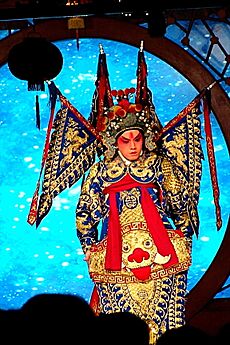
Flowers play an important role in Chinese decoration. A legend says that one day, Princess Shouyang, the daughter of Emperor Wu of Liu Song, was resting under plum trees. A plum blossom fell onto her face, leaving a flower print on her forehead. This made her look even more beautiful. The ladies of the court were so impressed that they started decorating their own foreheads with small, delicate plum blossom designs. This is the story behind the floral fashion called meihua zhuang (梅花妝; meaning "plum blossom makeup"). It started in the Southern dynasties (420–589) and became popular among ladies in the Tang (618–907) and Song (960–1279) dynasties.
Mongolian Royal Cheeks
Women from royal families in Mongolia painted red spots in the center of their cheeks, just below their eyes. The reason for this is still a mystery. They believed that red cheeks (like a blush) meant a happy queen. Blusher helps to shape the face and highlight the cheekbones, making the makeup look better.
Japanese Makeup Styles
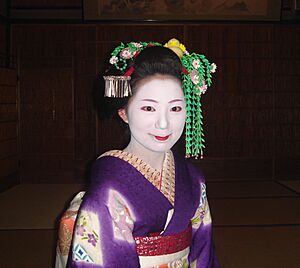
In Japan, geisha wore lipstick made from crushed safflower petals. They used this to paint their eyebrows, the edges of their eyes, and their lips. They also used sticks of bintsuke wax, a softer version of the wax sumo wrestlers use for their hair, as a makeup base. Rice powder was used to color the face and back. Rouge was used to shape the eye socket and define the nose.
Ohaguro (black paint) was used to color the teeth for a ceremony called Erikae. This is when maiko (apprentice geisha) become independent geisha. Geisha sometimes even used bird droppings to create a lighter color. The modern Japanese cosmetic industry began after the Meiji Restoration in 1868. New products for skin care and dermatology appeared in markets, thanks to new ingredients and technologies.
Cosmetics in Europe
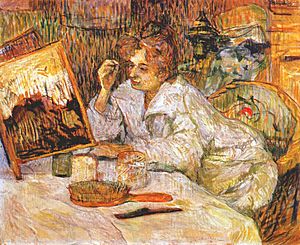
Ancient Greeks and Romans also used cosmetics. In the Roman Empire, rich women commonly used makeup. Some Roman writers didn't like this, thinking it went against traditional Roman values for women. Later, Christian writers shared similar feelings. Pliny the Elder mentioned cosmetics in his book Naturalis Historia. Ovid even wrote a book about it.
Pale faces were popular during the European Middle Ages. In the 16th century, some women would even bleed themselves to get pale skin. In the 13th century, Italian women wore red lipstick to show they were from the upper class. Cosmetics continued to be used in the Middle Ages, with people whitening their faces and rouging their cheeks.
Cosmetics were used in the centuries that followed, but attitudes towards them changed over time. At many points in Western history, using cosmetics was openly disapproved of. In the 19th century, Queen Victoria publicly said makeup was improper. She believed it was only acceptable for actors. Many famous actresses of that time, like Sarah Bernhardt and Lillie Langtry, did use makeup.
In the 19th century, women were expected to look delicate, feminine, and pale. Some achieved this with makeup. They might secretly use rouge on their cheeks. They also used drops of belladonna to make their eyes look larger. Even though many women used cosmetics discreetly, makeup was generally frowned upon in Western cultures during this time. This was especially true in the 1870s, when social rules became stricter. Teachers and clergy were specifically not allowed to use cosmetic products.
Cosmetics in Latin America
Beauty standards varied among different tribes. Cosmetics often showed a person's social class. These tribes usually applied products to their bodies as well as their faces. In Colombia, cosmetic products used oil or petroleum with various colors for the face and red for the body. More color often meant a woman was of a higher class.
The Maya used the color red to show social class. They also used this color in funeral ceremonies. The red pigment was made from minerals, some of which were not safe. Other products from animals and plants helped create many different shades of red. These shades varied in tone, intensity, and shine. Different reds showed a person's social status, as red represented luxury.
Other colors in Maya society were blue and green. These were made from plants like Indigofera and minerals like malachite. Similar to red, these colors were also used in funerals and to represent royalty. Orange and yellow were used for prestige too, made from minerals like hematite.
The Maya saw the body as a canvas for art. They often painted images of plants, animals, and humans. Other designs included personal patterns using geometric shapes.
The Chinchorro culture in northern Chile also saw the importance of the color red. It has been found on their mummies.
Modern Cosmetics
The 19th Century Boom
In the late 1800s, the Western cosmetics industry started to grow. People became more aware of how they looked. Attitudes towards colored cosmetics changed, and products became safer. Before the 19th century, it was hard for people to see their appearance regularly. This limited the need for a big cosmetic market. People usually made and used their own products at home.
Several new technologies in the second half of the century changed this. Innovations like better mirrors, commercial photography, advertising, and electricity in homes and public places made people more conscious of their looks. This created a demand for cosmetic products that improved one's image.
Homemade face powders, rouges, and lipsticks often had toxic ingredients. This made customers hesitant to use them. But new discoveries of non-toxic ingredients, like Henry Tetlow's use of zinc oxide for face powder in 1866, helped. Companies like Rimmel, Guerlain, and Hudnut started selling cosmetic products. This helped make cosmetics popular with more people.
Skincare products, along with "face painting" items like powders, also became popular. Large advertisements for cold cream brands like Pond's on billboards, in magazines, and newspapers created high demand. These advertising styles were soon copied in Europe, making the products even more popular there.
The 20th Century Transformation
In the early 1900s, makeup wasn't very popular. Most women hardly wore any. Makeup was mainly for performers in cabarets and on black-and-white screens. Applying actual paint to the face to look paler became popular among the rich. This practice was dangerous because the main ingredient was often a harmful substance. Pale skin was linked to wealth because it meant you didn't have to work outside in the sun.
Cosmetics were so unpopular that you couldn't buy them in department stores. They were only sold in theatrical costume shops. A woman's "makeup routine" often just involved using powdered paper to whiten her nose in winter or shine her cheeks in summer. Some women used burnt matchsticks to darken eyelashes. They used geranium and poppy petals to stain their lips. Vaseline became very popular for chapped lips, as a hair tonic base, and as soap. Light perfumes were introduced, but only certain scents were acceptable for women. Cosmetic deodorant was invented in 1888 and trademarked as "Mum". Roll-on deodorant came out in 1952, and aerosol deodorant in 1965.
Around 1910, makeup became fashionable in the United States and Europe. This was thanks to ballet and theatre stars like Mathilde Kschessinska and Sarah Bernhardt. Colored makeup arrived in Paris with the Russian Ballet in 1910, with popular shades of yellow-brown and deep red. A beauty book showed that cosmetics were now acceptable for many people to wear. This book was one of the first to suggest using an eyeliner pencil to make eyes look longer and an eyelash curler to make lashes stand out. Eyebrow darkener, made from tree sap, ink, and rosewater, was also shown.
George Burchett developed cosmetic tattooing during this time. He could tattoo pink blushes, red lips, and dark eyebrows. He also helped men disfigured in the First World War by tattooing skin tones onto damaged faces and covering scars. Max Factor opened a professional makeup studio for actors in Los Angeles in 1909. Even though it was for actors, regular women came to buy theatrical eye shadow and eyebrow pencils for home use.
In the 1920s, the film industry in Hollywood had the biggest impact on cosmetics. Stars like Theda Bara greatly influenced the makeup industry. Helena Rubinstein was Bara's makeup artist. She created mascara for the actress, based on her experiments with kohl. Others who saw the chance for mass-market cosmetics were Max Factor Sr. and Elizabeth Arden. Many of today's makeup companies started in the 1920s and 1930s.
Lipsticks were very popular then, even more than rouge and powder, because they were colorful and cheap. In 1915, Maurice Levy invented the metal lipstick container, which allowed for mass production. The Flapper style also influenced 1920s cosmetics, with dark eyes, red lipstick, red nail polish, and the suntan. The suntan became a fashion statement thanks to Coco Chanel. The eyebrow pencil became very popular in the 1920s, partly because it was much better than before, thanks to a new ingredient. Early commercial mascaras were simple pressed cakes of soap and pigments. Women would dip a tiny brush in hot water, rub it on the cake, and apply it.
Eugène Schueller, who founded L'Oréal, invented modern synthetic hair dye in 1907. He also invented sunscreen in 1936. The first patent for a nail polish was given in 1919. Its color was a very faint pink. Before Chanel, only outdoor workers had suntans, while fashionable women kept their skin as pale as possible. After Chanel made suntans popular, many new fake tan products were made to help people get the "sun-kissed" look. In Asia, skin whitening continued to be the ideal of beauty, as it still is today.
After the First World War, there was a big increase in cosmetic surgery. In the 1920s and 1930s, plastic surgeons focused on changing facial features and social identity. Face-lifts were done as early as 1920. But it wasn't until the 1960s that cosmetic surgery was widely used to reduce signs of aging. In the 20th century, cosmetic surgery was mainly for women. Men only had it if they were disfigured by war. Silicone implants were introduced in 1962. In the 1980s, doctors worked to make the public more aware of plastic surgery. In 1982, the United States Supreme Court allowed doctors to advertise their procedures. These ads often made surgeries seem risk-free, even though they weren't. In 1998, over two million Americans chose to have cosmetic procedures.
In the 1920s, many African Americans used skin bleaching to lighten their complexion. They aimed for a brown tone, seen as an "intermediate" between black and white. Skin bleaches and hair straighteners made millions of dollars. They accounted for a large part of all advertisements in black newspapers. Often, these products were created and sold by African American women themselves. Skin bleaches contained strong chemicals that could cause skin problems.
In the 1970s, at least five companies started making makeup for African American women. Before then, makeup shades for Black women were limited. Face makeup and lipstick made for pale skin tones often made dark skin look gray. Makeup artists like Reggie Wells, who worked with Black celebrities like Oprah Winfrey, developed their own shades. Eventually, makeup companies created products that matched richer skin tones, like foundations and powders. Popular companies like Astarté, Afram, Libra, Flori Roberts, and Fashion Fair priced their cosmetics affordably to reach many people.
Black women also became a big part of the hair care market in America. New technology in the 1940s and 1950s gave Black women more options for hair straightening. In 1954, George E. Johnson started the Johnson Product Company. He introduced a safe hair straightening system that could be bought in stores and used at home. As America moved into the 1960s and 1970s, the afro became a popular hairstyle. This required new beauty products. The afro became a symbol of naturalness and grew with the "Black is Beautiful Movement." Johnson Product Company created various hair care products to maintain the Afro look. Products like Afro Sheen and Ultra Sheen became popular. As Black consumerism grew, White-owned companies also tried to enter the Black hair care industry. Clairol created products and ads aimed at supporting Black hair.
During the Second World War (1939-1945), cosmetics were hard to find. Ingredients like petroleum and alcohol were used for war supplies. Even though they were limited, lipstick, powder, and face cream were highly desired. Cosmetic developers realized that the war would lead to a huge boom afterward, so they started preparing. Companies like Yardley, Elizabeth Arden, Helena Rubinstein, and a French company became known for "quality" after the war because they were the oldest. Pond's had a similar appeal in the lower price range. Gala cosmetics was one of the first to give its products fun names, like lipsticks in "lantern red" and "sea coral."
In the 1960s and 1970s, many women in the Western world, influenced by feminism, chose not to wear any cosmetics. In 1968, at the feminist Miss America protest, protestors symbolically threw feminine products, including cosmetics, into a "Freedom Trash Can."
Non-allergic makeup appeared when the "bare face" was in fashion. Women became more interested in the ingredients of their makeup. Modern technology helped create cosmetics that looked more natural and lasted longer. The main cosmetic of the time was eye shadow. Women were also interested in new lipstick colors like lilac, green, and silver. These lipsticks were often mixed with pale pinks and whites, so women could create their own shades. "Blush-ons" came into the market, with Revlon making them very popular. This product was applied to the forehead, lower cheeks, and chin. Contouring and highlighting the face with white eye shadow cream also became popular. Avon introduced the lady saleswoman. In fact, the whole cosmetic industry created opportunities for women as business owners, inventors, manufacturers, and promoters.
The 21st Century and Beyond
Today, beauty products are widely available online. Dedicated internet stores and traditional department stores now sell cosmetics.
Like most industries, cosmetic companies often resist rules from government agencies. In the U.S., the Food and Drug Administration (FDA) does not approve or review cosmetics. However, it does regulate the colors that can be used in hair dyes. Cosmetic companies are not required to report injuries from their products.
While makeup has traditionally been used mainly by women, more and more men are now using cosmetics. They use them to enhance their facial features. Concealer is commonly used by men who care about their appearance. Cosmetic brands are releasing products specifically for men. There is some debate about this. Some people feel that men wearing makeup are not following traditional gender roles. Others see it as a sign of more gender equality. They believe men should also have the right to enhance their features if women do.
Today, the cosmetics market is very different from the 20th century. Some countries are leading this economy:
- Japan: Japan is the second largest market in the world. The cosmetics market in Japan has become stable. However, the market is changing quickly. Consumers can now find a lot of information online and choose many different products. This creates opportunities for new companies to meet diverse needs. In 2010, the market was worth 2286 billion yen. It had a growth rate of 0.1%, so it was almost unchanged from the previous year.
- Russia: Russia is an interesting growing market. It was the 5th largest in the world in 2012. The Russian perfume and cosmetics market has shown the highest growth of 21% since 2004, reaching US$13.5 billion.
- South Korea: South Korea's cosmetic industry is growing fast with its unique products, light ingredients, and pretty packaging. In 2020, the market was worth $6.8 billion, but lost $2.6 billion due to COVID-19. The total export of products increased by 16%. France was the largest importer, followed by the United States and Japan. Skincare products are still the most imported items at 34.17%, along with perfumes and haircare products.
Because of COVID-19 pandemic lockdowns and people being careful about going to salons, trends that copied salon procedures started to appear. These included more complex home skincare routines, hair color-preserving products, and beauty tools. Early in the pandemic, sales of makeup essentials like foundation and lipstick dropped by up to 70% because people were staying home and wearing face masks.
In Latin America, the cosmetic and personal-care industry has grown a lot and become more diverse. The idea of using sustainable ingredients in products is now important. Companies are looking for alternatives to certain additives. For example, one ingredient used in products is epseama, which comes from seaweed. This ingredient acts as an anti-aging agent in skin products.
Men and Makeup Today
In the 1970s, male musicians started using makeup on stage. This included famous rock stars like David Bowie, Alice Cooper, and the band Kiss. Using cosmetics helped them create a different stage personality. It was part of the visual show. Today, the popularity of TikTok has led to a rise in men's cosmetics. Some men choose to wear nail polish, makeup, and other cosmetics to express themselves online.
|
See also
- Cosmetics
- Female cosmetic coalitions
- Ochre
- Prehistoric art
- Symbolic culture
- Blombos Cave



